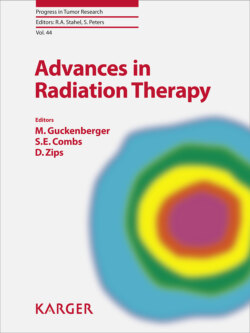Читать книгу Advances in Radiation Therapy - Группа авторов - Страница 40
На сайте Литреса книга снята с продажи.
MRI-Based Hypoxia Imaging
ОглавлениеBesides PET, hypoxia and perfusion may also be visualized with MRI. Different MRI protocols have been suggested for this, for instance dynamic contrast enhanced (DCE) MRI in which gadolinium is typically used as a paramagnetic contrast agent. With DCE MRI, different parameters can be retrieved (e.g., ktrans/kep, ve) for the visualization of tissue perfusion.
Reduced perfusion might indicate tumor hypoxia, and therefore DCE MRI can be used as a surrogate for hypoxia imaging. However, increased vascular permeability leads to higher intratumoral contrast agent levels, while it may be associated with increased hypoxia [37, 44].
Other examples of interesting sequences/protocols, although not (yet) with a proven predictive value, are blood-oxygen level-dependent (BOLD) MRI [45], which visualizes the ratio between paramagnetic deoxyhemoglobin and diamagnetic oxyhemoglobin, and the less mature tissue oxygen level dependent (TOLD) MRI, and mapping of oxygen by imaging lipid relaxation enhancement (MOBILE). These could be used for the visualization of tissue oxygenation in water and in lipids, respectively [44].
In MRI, the acquisition itself can be performed with many different settings, and many different parameters can be retrieved from the acquired data. Without denying the value of this field of research, in depth discussion about the advantages and disadvantages of these different techniques and applications is not included here.
